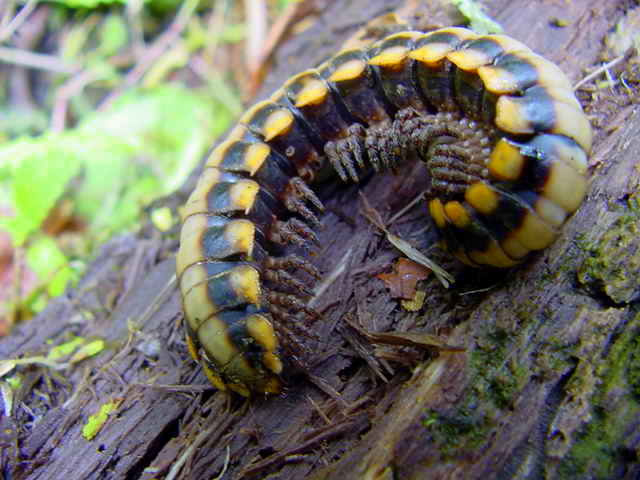
More about Millipede
Habitat
Like other millipedes in Central America, this species sticks to dark, humid nooks within the forest, favoring rotting trees, piles of leaf litter and soil, caves, and other concealed places.
Physical Description
With a thick, shiny armor and yellow-orange and black striping, this millipede may appear threatening. Its body is comprised of 20 segments, most of which have two pairs of legs.
Millipedes and centipedes are often confused with one another. Millipedes have legs that come in pairs, and depending on the species and how fast they are moving, you can notice the legs moving two by two. Millipedes tend to move slower than centipedes, so if you see one of these many-legged insects racing across the forest (or house) floor, it is probably not a milipede.
Biology and Natural History
This insect is a commonly found friend of forest floors, where it sifts through the leaf litter, chewing up decaying wood and other plants. These millipedes are greatly important to the health of the forest, as they assist the decomposition of dead or dying plant matter.
Partly because it is an herbivore, the millipede does not move quickly or have venom like the hasty, biting centipedes which hunt other insects. This species of millipede has a tough exoskeleton, a hefty size, and bright warning colors. Rather than run or bite, it will instead curl up and release an unpleasant liquid from its rear which contains hydrogen cyanide and benzaldehyde. This liquid can ooze or eject from the millipede, and while it is not potent enough to threaten human health, it is better to wash the skin it touched.
Diet
Mostly plant matter and decaying wood make up the meals for this millipede.
Height/Weight
Adult females of this species grow to about 10 cm. Males are a little smaller.
Taxonomy
Order: Polydesmida
Family: Platyrhacidae
Sources
Hogue, Charles L. Latin American Insects and Entomology. University of California Press: Berkely and Los Angeles, 1993.
Heisler, I. L. in Janzen, Daniel H. Costa Rican Natural History. Chicago: University of Chicago Press, 1983.
Kricher, John. A Neotropical Companion: an introduction to the animals, plants, and ecosystems of the New World tropics. Princeton University Press: Princeton, NJ, 1997.
Amy Strieter, Wildlife Writer
Similar Profiles
It's more than just having a good time or visiting beautiful places (although that's absolutely a part of it!), it's about being part of a unique experience that stays with you.



